October 26, 2012
Air Date: October 26, 2012
FULL SHOW
SEGMENTS
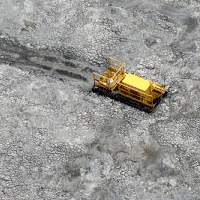
First Nation Challenges Expansion of Canada’s Tar Sands
View the page for this story
Canada’s tar sands cover an area the size of New York State. Now Shell Canada wants to expand its Jackpine tar sands mining operations, but several First Nations communities who live there fiercely protest the plans. Living on Earth host Steve Curwood hears why from Chelsea Flook, Executive Director of the Sierra Club Prairie Chapter. (06:20)
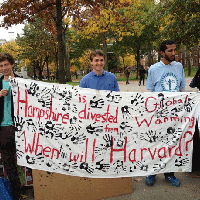
Students Demand Fossil Fuel Divestment
View the page for this story
Some 25 yrs ago, students demanded their universities pull investments out of South Africa to fight Apartheid. Now, activists want to fight climate change emissions using the same tactic. Host Steve Curwood talks to Harvard students who are asking the college to pull investment from all fossil fuel stocks. (05:45)
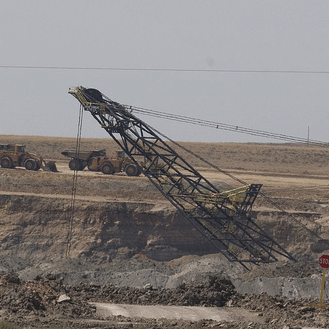
Exporting Wyoming Coal to Asia
/ Ashley AhearnView the page for this story
Coal mines are booming in the Rocky Mountain West, and mining companies need expanded deep water terminals. Asia is hungry for coal, but some Pacific coast residents are not in favor of huge new export facilities at their ports. Ashley Ahearn of the Public radio collaborative EarthFix reports. (05:00)

Power Shift - Hospitals Go Green to Save Money and Save Lives
View the page for this story
In an effort to reduce climate vulnerability and stabilize energy costs, hospitals nationwide are investing in energy efficiency and renewable energy. Host Steve Curwood checks out the innovative design of the new Spaulding hospital with John Messervy Director of Capital and Facilities Planning for Partners' HealthCare. (09:45)
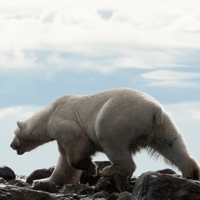
The Long Rise: Mark Seth Lender
/ Mark Seth LenderView the page for this story
In the far north, in summer months dawn starts early and the light grows almost imperceptibly. One early morning, writer Mark Seth Lender, author of A Salt Marsh Diary, found himself out on the tundra, with three polar bears. (02:45)
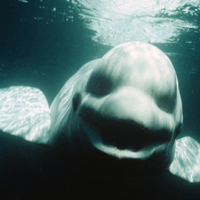
The Whale that Spoke Human
/ Emmett FitzGeraldView the page for this story
Whales are famous for their intelligence, and a new paper from neurobiologist Sam Ridgway argues that at least one beluga whale could imitate human speech patterns. Living on Earth's Emmett FitzGerald reports on Noc, the cetacean with the remarkable vocal powers. (04:20)
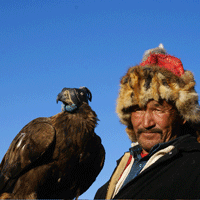
Eternity of Eagles
View the page for this story
Stephen Bodio is a naturalist, falconer, and writer whose travels have taken him all around the world. During the 1990s, he lived with Kazakh tribes of central Asia, who use eagles to hunt wolves. Bodio discusses with host, Steve Curwood his new book a compendium of all things eagle called An Eternity of Eagles. (10:25)
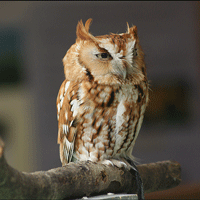
BirdNote®: Screech-Owl
/ Mary McCannView the page for this story
Of all familiar birds, the Screech-Owl has the spookiest and scariest calls, as Mary McCann explains in this week's BirdNote®. (02:05)
This week's EarthEar selection
listen /
download
The haunting sound of a lone Humpback whale, Megaptera Novoangliae, recorded in the Caribbean by the Internatonal Fund for Animal Welfare for the British Library CD, Sounds of the Deep.
Show Credits and Funders
Show Transcript
HOST: Steve Curwood
GUESTS: Chelsea Flook, Alli Welton, Chloe Maxmin, Gary Cohen, John Messervy, Sam Ridgway, Steve Bodio
REPORTERS: Steve Curwood, Ashley Ahearn, Emmett Fitzgerald, Mary McCann
[THEME]
CURWOOD: From Public Radio International - this is Living on Earth. I'm Steve Curwood. Students call on their universities to pull endowment investments out of fossil fuel companies:
OLIVER: I think climate change is a really important issue and one that Harvard should be dong more to tackle through its investments - I mean Harvard draws a moral line in the sand somewhere - it doesn't invest in tobacco companies on health grounds and if climate change isn't a public health issue then I don't know what is.
CURWOOD: Hampshire College agrees, but Harvard and most endowment managers see the issue differently. Also, controversy over the prospect of exporting coal from the Western US to Asia:
MORSE: Are the emissions that come out of the West coast if they export that coal going to make or break climate change? No. Is how we deal with that going to set an important precedent for other fuels? Yes it is.
CURWOOD: Export earnings and jobs versus the global climate; that and more this week, on Living on Earth. Stick Around!
[THEME]
ANNOUNCER: Support for Living on Earth comes from Stonyfield Farm.
First Nation Challenges Expansion of Canada’s Tar Sands

Canadian Tar Sands. http://sierraclub.typepad.com/compass/tar-sands/
CURWOOD: From the Jennifer and Ted Stanley Studios in Boston, this is Living on Earth. I'm Steve Curwood. The tar sands of Canada are so rich the nation's second only to Saudi Arabia for proven crude oil reserves. One of the companies developing the sands, Shell Canada, wants to expand its operations. But this region is also home to several indigenous First Nations communities who fiercely protest Shell’s plans.
The Athabasca Chipewyan First Nation - ACFN - has challenged the expansion plans in court. Chelsea Flook is Executive Director of the Sierra Club Prairie Chapter - welcome to Living on Earth.
FLOOK: Hello, thanks for having me!
CURWOOD: Now tell me, the First Nation objects to Shell’s plans to expand its Jackpine tar sands mine, why?
FLOOK: Well, the complaints are numerous. It stems back to the earlier Jackpine mine where Shell made an agreement with the Athabasca Chipewyan First Nation on mitigating impacts. And Shell, according to ACFN, has broken that agreement. When it comes time to making a decision on the new project, how can the First Nation expect any of its concerns to be addressed when, even when you sign a deal with the exact same company, that they don’t honor those agreements?
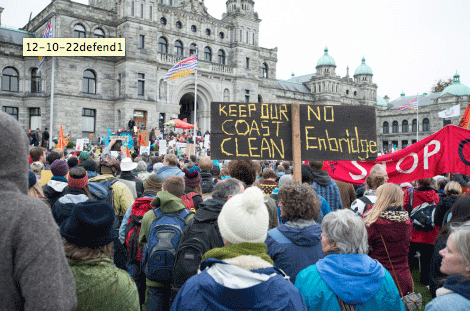
Enthusiastic crowd on the steps of the BC legislature in Victoria, protesting tar sands pipelines, tankers, and the threats they pose to the west coast.
CURWOOD: Well, what are they saying didn’t happen, I mean, what does it actually look like up there?
FLOOK: The Shell project is open top mining - the new expansion requires mining out 21 kilometers of the Muskeg River, which is, you know, aside from mining the river and all of the environmental impacts, there are all kinds of cultural significance of that area of the river to the Athabasca Chipewyan First Nation people. So they are saying ‘no’ to this project, and they want to be able to assert that right to say no, as it’s been enshrined in the treaty rights and constitutional protections, and that’s why they’re raising this case now.
CURWOOD: So, the First Nation argues that it would be illegal for the Canadian government to give the OK to expand these tar sands and mines, what’s the legal basis for that?
FLOOK: Well, the legal basis stems back to treaty rights between the Crown and treaty peoples - the first peoples of this land. Those agreements were enshrined in the constitution when Canada brought the constitution home, and it was sort of written in under section 35 that treaty rights people and indigenous people of this land have special constitutional considerations, for development of their land, for any kind of disturbance of their land, and it really tried to enshrine the idea that… so long as the grass grows, and the river flows, and the sun shines, that the people can be there time immemorial.
So parts of these projects are having such massive impacts on the land, on the water, on the wildlife – that people are still dependent on – and so they are seeing more and more that their medicines are disappearing, the water levels are getting lower, they’re not sure if it’s safe to eat the fish or drink the water.
They’re finding moose and other animals that they eat with various tumors and lesions and things, and so the basis for them saying ‘no’ to this is that it’s constitutionally enshrined for them to do so, however, we have a federal government that’s pretty much hell-bent on developing these things, pretty much at any and all costs.
CURWOOD: So, if I understand you correctly, this treaty was made with the Crown, in other words – well, that must have been Queen Victoria of England, this was more than 100 years ago.
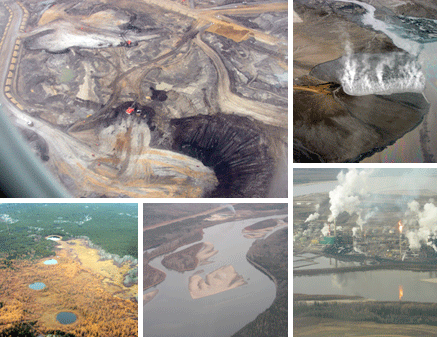
Alberta Tar Sands – In Photos. Top left - Overhead of mining operation, top right - tar sands tailings, lower left - sink holes of the McClelland Lake Wetland Complex, lower middle - the low flow of the Athabasca River, and lower right - oil sands upgrader. Photos by Lindsay Telfer.
FLOOK: Yes. And so part of that process was when Canada made its own constitution separate from the British Constitution, part of what was written into it was the recognition that there were past agreements and that they were going to do their best to honor those agreements.
This, however, you know, is running up against the history of various pieces of legislation like the Indian Act, which restricted status, it didn’t let native people vote, it restricts many things about their lives... they have to have status cards, and Canada has a long history of residential school systems where they sought to literally ‘kill the Indian in the child,’ as it was said in the original documents.
So, there’s this long process where there’s a cultural and very historical genocide that’s happening against these people where if you can take them off their land, if you can displace them from practicing their traditional ways, then those treaty-like rights no longer exist.
CURWOOD: Now, how is the Canadian government reacting to the First Nation’s case regarding these tar sands?
FLOOK: They are there as interveners, they are also there as the judge, jury, and executioners of the whole project, so they have a little bit of a conflict of interest, in our opinion. One of the former ministers, Jim Prentice, who left his post, he penned a letter to our mainstream media here in Canada saying, you know, the duty to consult has not been met in these projects.
And that leaves a lot of these projects open to a lot of financial risk, and this has basically exposed the public to a lot of this risk, because, if in fact these treaty rights are pushed forward, and those people do push for them to be respected, then a lot of those land leases mean that the public would have to reimburse these companies for the land leases that they purchased illegitimately.
CURWOOD: What does this situation mean now for the future of resource development and indigenous people’s rights in Canada?
FLOOK: Well, I think that there’s been a couple test cases at the Supreme Court level where various communities have asserted their rights and taken it all the way to the Supreme Court. And Supreme Court has left things open to rulings, very much so, that would favor the ACFN in this case.
So I think that this could really set a precedent in the tar sands region alone, for more and more of these communities to stand up to these major oil companies and expect that their voices will be heard.
CURWOOD: Chelsea, what’s the best possible outcome from this from your perspective?
FLOOK: Well, I think that the best possible outcome from our perspective at Sierra Club would be that we see a First Nation asserting its rights to say ‘no’ to a project, and that that would get respected. It’s also enshrined in the UN Declaration of the rights of indigenous peoples to say ‘no’ to these projects with free, prior, and informed consent.
So I think that Canada has at least a moral obligation to look at itself and look at the UN declaration, and start taking meaningful action on those moral imperatives. So that’s our hope there, and if it just so happens that First Nations are deciding that they want to protect their land and their way of life, then there are environmental benefits to that as well.
CURWOOD: Chelsea Flook is the Executive Director of the Sierra Club Prairie Chapter in Edmonton, Alberta. Thanks so much for taking the time, Chelsea!
FLOOK: Alright, thanks so much for having me!
CURWOOD: In published reports, Shell Canada said that, though expanding would cause substantial habitat loss, it has extensive plans to mitigate the damage.
The Canadian Government did not reply to numerous requests for comment before we recorded our show, but sent a statement later, saying there are 2 separate mandated independent environmental review panels and "The Government trusts that the joint review panels will receive and consider information from Aboriginal groups related to how these projects may affect potential or established Aboriginal and treaty rights before they issue their reports."
Related links:
- The Alberta government’s website about Alberta’s Oil Sands
- The Sierra Club. The Dirty Truth About Canada’s Tar Sands Industry
- Indigenous Environmental Network’s Tar Sands Campaign
Students Demand Fossil Fuel Divestment
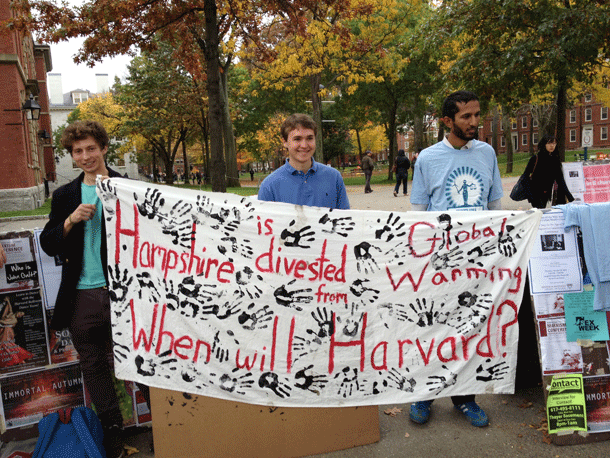
Harvard students hold up a sign encouraging the university to divest from fossil fuels (Photo: Annie Sneed)
CURWOOD: A new battle-line has formed in the wider push to rein in fossil fuel use – on college campuses. Students at some 18 colleges and universities just held a National Day of Action to pressure their administrations to divest their endowment holdings from fossil fuel stocks, a move already taken by Hampshire College in Western Massachusetts.
Among the institutions involved - Cornell, Amherst, Bryn Mawr, Boston University – and the university with the fattest endowment of all – Harvard. Down in Harvard Yard I met one of the organizers of the protest, sophomore Alli Welton.

Harvard student Alli Welton (Photo: Annie Sneed)
WELTON: I think students feel very scared and worried about climate change because this issue will really determine the sort of planet that we live on and the society in which we have our lives. And I think it’s particularly strong to students because we see our entire lives spread out ahead of us.
Also, we’re trying to raise awareness among the members of our administration that the impacts of climate change are already happening right now, and they’re already taking a serious toll – if you look at the drought in the Midwest this summer, the wildfires in Colorado…– we just feel that it’s a really important issue that needs some action right now.
CURWOOD: Harvard has, certainly, the largest endowment of any American university, how much of it is fossil fuel, do you think?
WELTON: So, we can’t give an exact number because not all of Harvard’s endowments or investments are made public. University endowments are generally un-transparent and there have been campaigns for years and years to try to make them transparent. So, the portions of the endowments that we are able to see, it is very clear that Harvard has invested in oil, coal, and natural gas companies, and the Harvard management company confirmed this with us.
CURWOOD: Harvard says it’s in its best interest to have these investments to make money to support the operations - what do you think’s in Harvard’s best interest?
WELTON: I think Harvard’s best interest is maximizing its positive impact on the world, and I think President Faust would make the argument that earning the most money out of our endowment to pay for researchers – the production of knowledge – as she says, is the most important thing.
But if we don’t have a planet that’s stable to live on… I mean, various studies predict that the carrying capacity of the earth will be one billion people by the end of the century… I mean, what kind of Harvard would that be? Climate change is about whether or not Harvard survives as an institution, which is why we feel that it’s so important that we divest from fossil fuels.
CURWOOD: Now, Harvard says, the President of Harvard says it’s her fiduciary responsibility to keep these investments, how do you respond to that?
WELTON: President Faust’s responsibility is to look out for Harvard’s institutional well-being as a whole. And I understand that part of that is earning money off the endowment, so we can have an operational budget and such, but part of that is also that these investments in fossil fuel companies are also threatening Harvard.
Both our students, in terms of our lives, wherever we go in the world after this – climate change could really harm our lives or our chances of getting a job if the economy is strained under increasingly frequent natural disasters, or even Harvard itself… I mean rising sea levels will mean that the Charles River starts to flood.
And if you look at the city of Cambridge’s projections for this, the floodwaters will go right up into where we have our dorms right now – right into the Kennedy School and the Business School. So we think that the President needs to consider that when she thinks about her responsibility for Harvard and how it invests its money.
CURWOOD: Alli Welton helped organize the National Day of Action for Fossil Fuel Divestment. She says they've collected nearly a thousand signatures from students who support them.
OLIVER: My name's Oliver. I’m here today to support the Students for a Just and Sustainable Future in calling for Harvard to divest from fossil fuels, because I think that climate change is a really important issue and one that Harvard should be doing more to tackle through its investments. I mean, Harvard draws a moral line in the sand somewhere – it doesn't invest in tobacco companies on health grounds and if climate change isn't a public health issue then I don't know what is.
MAXMAN: My name is Chloe Maxmin.
CURWOOD: Why are you here today?
MAXMIN: I’m here because I believe that climate change is the defining issue of our generation, and for a long time environmentalists have been trying to fight global warming by promoting individual action and changing light bulbs, and all that’s important and it brings those issues into the psyche, but when you turn on your light bulb, it’s still powered by coal. And so now this divestment movement is fighting the fossil fuel industry directly, which is why I think it’s taken off so quickly, is because people can see that their individual voices are going to have an impact.
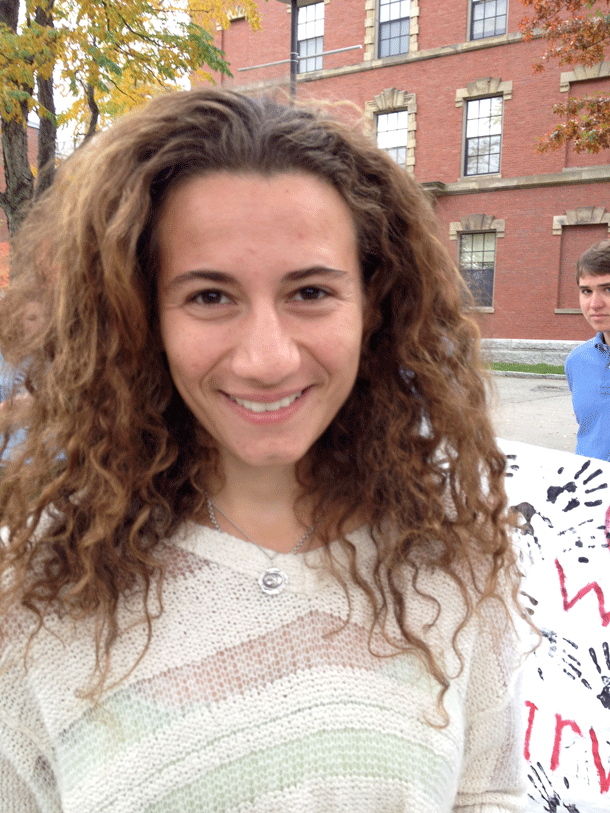
Harvard Student Chloe Maxmin (Photo: Annie Sneed)
CURWOOD: And you’ve spoken with the President of Harvard about this? What did she tell you, and what did you tell her?
MAXMIN: We told her that Harvard, as a leading moral institution in our society, has a responsibility to stay true to its values of promoting service and education in America and around the world, and that by investing in fossil fuels, we are potentially going against all of our gains that we have on campus through our green buildings and our sustainability education, and we want her to uphold the values that our institution proposes to promote throughout society.
And she said that Harvard would not be divesting from climate change because our endowment is not something we use to pursue social goals, but we know that that’s not true, because Harvard divested fully from big tobacco, and we also sold 50 million dollars worth of Citibank securities during the South African divestment movement.
CURWOOD: Chloe Maxmin. Harvard provided a statement explaining that they have divested on rare occasions, but quote: “The University maintains a strong presumption against divesting itself of securities for reasons unrelated to investment purposes…."
Related links:
- National Day of Action for Fossil Fuel Divestment
- DIVEST HARVARD/Facebook
- Bill McKibben's National Divestment Tour
[MUSIC: Garage A Trois “Dory’s Day Out” from Power Patriot (Royal Potato Family 2000).]
CURWOOD: Just ahead – Wyoming and Montana are mining vast amounts of coal - but they need deep-water terminals to get it to lucrative markets in Asia. Stay tuned to Living on Earth!
[CUTAWAY MUSIC: Jimmy Heath “Who Needs It?” from The Thumper (Solar Records 2012 reissue).]
Exporting Wyoming Coal to Asia
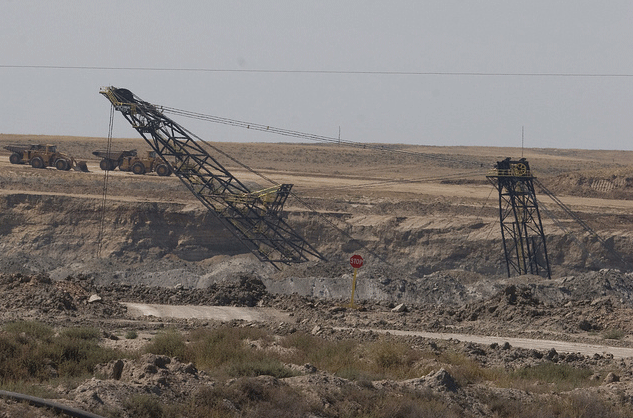
An open pit coal mine in the Powder Ridge Basin of Wyoming. (Photo: Kimon Berlin)
CURWOOD: It’s Living on Earth, I'm Steve Curwood. Coal companies are looking to the Pacific Northwest as the fastest way to bring the huge quantities they're mining from Wyoming and Montana to Asian markets.
There are now at least five ports in Washington and Oregon considering coal export terminals. Last week we reported on those mining operations, and in the second part of our series on Coal in the Northwest we head to what might one day become the largest coal export facility on the West Coast. Ashley Ahearn of the public radio collaborative EarthFix has our story from Bellingham, Washington.
[BOAT ENGINE FADES UP]
AHEARN: Kevin Ranker points his motorboat towards Cherry Point and guns the engine.
RANKER: It’s gonna be a bumpy one!
AHEARN: Ranker’s the state senator who represents the nearby San Juan Islands. As we come around a bend in the coast we can see an oil refinery and an aluminum smelter off in the distance. Between them is a long stretch of tree-lined waterfront. This is the proposed site of the Gateway Pacific Terminal.
It would be big enough to handle 48 million tons of coal per year. That’s equivalent to almost half the amount of coal the entire country exports right now. Almost 500 ships a year would be passing through this waterway on their way to and from Asia.
As an islander, Ranker spends a lot of time on the water. So do many of his constituents. He shares their fear that all of these ships moving back and forth will increase the likelihood of an oil spill.
RANKER: I’m hearing a lot of concern. Mostly from people who are fearful of what this will mean. We’re going to see an environmental and an economic impact that will devastate Washington State.
AHEARN: Each of these ships carry hundreds of thousands of gallons of bunker fuel. Ranker looks across the water at an oil tanker parked at the refinery.
RANKER: If we dramatically increase the vessel traffic then we need to dramatically increase the oil spill preparedness and response program and who’s going to pay for that increase?
AHEARN: That’s one of the questions at the core of the debate over coal exports in the Northwest: Who picks up the tab? Ranker’s not getting an answer to that question. The coal companies have been very good to Wyoming. They’ve funneled millions of tax dollars into state and county coffers to build things like recreational centers, schools and other public projects.
But that’s money for Wyoming. Those companies aren’t based in Washington or Oregon, so the Northwestern states won’t see direct tax revenue from them. Craig Cole is a spokesman for the Gateway Pacific Terminal. He argues that economic activity anywhere in the country is good for the entire country.
COLE: I guess you could say that building cars in Detroit doesn’t help us but yes it does, because it strengthens the national economy and we’re a part of that.
AHEARN: If all five proposed terminals in Washington and Oregon are built they would create hundreds of long-term jobs at the ports, with several thousand workers employed during the initial phases of construction.
The Association of Washington Businesses as well as some of the most powerful labor unions in Oregon and Washington have come out in support of coal exports. Craig Cole says that’s no surprise in this economy.
COLE: I’m kind of pragmatic. I think if we’ve got something that can fuel jobs in our country, and fuel our economy and rebalance trade, we should take advantage of it. Right now we need to sell whatever we can sell, whether it’s a natural resource based commodity or whether it’s high tech.
AHEARN: Environmental groups say the full cost of exporting coal through the Northwest outweighs the economic benefits. Increased train traffic will mean more air pollution, dust, noise and traffic disturbances in communities along the rail lines. And that’s to say nothing of the effect of burning the coal at the end of its voyage to Asia.
MORSE: Coal is the single largest source of CO2 emissions, which makes it really the heart of the climate problem.
AHEARN: Richard Morse is a coal expert at the Program on Energy and Sustainable Development at Stanford University. He says global coal consumption is expected to rise by 65 percent in the next 20 years or so. Right now Asia uses five billion tons of coal every year. The amount of coal that would be exported through the Northwest would be about two percent of that.
MORSE: Are the emissions that come out of the West coast if they export that coal going to make or break climate change? No. Is how we deal with that going to set an important precedent for other fuels and future more comprehensive policy? Yes it is.
AHEARN: Right now the U.S. doesn’t have a national policy in place to limit greenhouse gas emissions. That means coal can’t legally be treated differently than any other commodity, despite its potential to change the global climate.
Washington Congressman Jim McDermott recently introduced a bill that would tax carbon* – and therefore, coal exports. (See correction below). The revenue would go towards the national debt and towards helping communities - like those in his home state - deal with the impacts of increased train and ship traffic from moving coal.
It’ll be a tough bill to pass. For now, the opposing sides of the coal export debate in the Northwest are squaring off as the two largest proposed terminals begin the environmental review process this fall. I’m Ashley Ahearn in Bellingham, Washington.
CURWOOD: Ashley Ahearn reports for the public radio collaborative EarthFix.
*ERROR AND CORRECTION: Congressman McDermott has introduced a carbon tax measure, but it would not apply to the shipping of coal for export. The bill he filed that would impose a $10 per ton tax on extracted coal is called the "True Coast of Coal Act." Tax proceeds would fund the mitigation of any adverse effects from the shipping of coal. See the link below this story for more details.
Related links:
- Earth Fix based out of KUOW in Seattle
- Cong. McDermott's statement on "True Cost of Coal Act"
[MUSIC: Jacob Fred Jazz Odyssey “Trampoline Phoenix” from Stay Gold (Royal Potato Family 2010).]
Power Shift - Hospitals Go Green to Save Money and Save Lives
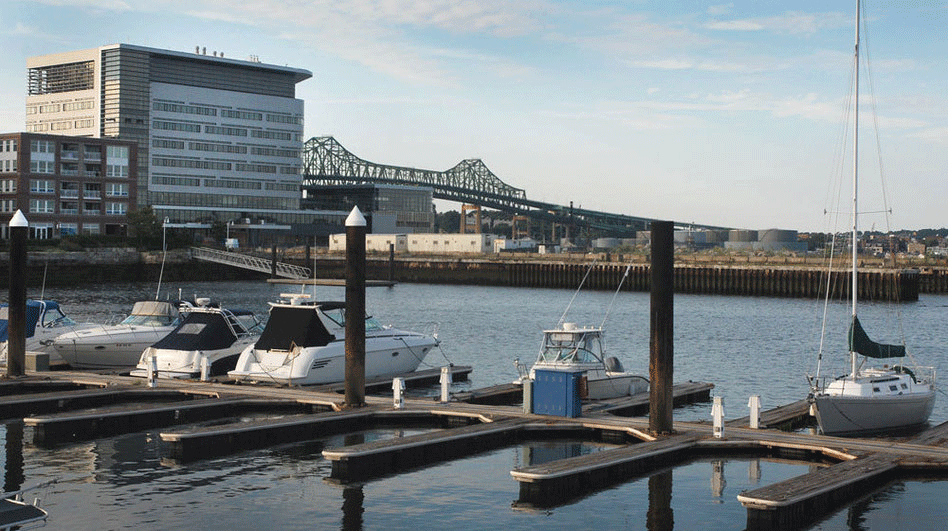
Spalding Hospital sits on Boston Harbor in Charlestown. (Photo: Robin Lubbock/WBUR)
CURWOOD: Generally the best way to reduce carbon pollution and emissions is to use less energy, and the dividends can add up fast for big buildings. Consider the health care sector, which is almost a fifth of the national economy. Hospitals and clinics are the second most intensive users of energy after the food service industry and contribute roughly 8% of US global warming gas emissions. Gary Cohen, president of Health Care Without Harm, says it’s no surprise that hospitals use so much energy.
COHEN: Well, they operate 24/7. They have a lot of electronic equipment and they continue to get more electronic equipment. More MRIs, more robotics… all of these are enormous energy users.
CURWOOD: So, we spend one out of five bucks on health care and it's one out of say 12 electrons on health care.
COHEN: That’s why focusing on the healthcare sector as the wedge sector in society to lead on reducing greenhouse gas emissions is a really smart strategy. We need to have health care institutions be models for climate preparedness and climate resiliency so that in an extreme weather event maybe the hospital or the clinic is the one place with reliable power to keep medicines refrigerated because they’re using renewable energy.
It may be the one place in times of extreme flooding that has water filtration so that everyone can get clean water. So we need to rethink hospitals as anchors for healthier communities and not just being centers for disease management.
[CONSTRUCTION SOUNDS]
CURWOOD: On the shore of Boston Harbor, Partners, one of the nation’s leading health care providers, is incorporating conservation and the strategy of climate resilience in the replacement for its Spaulding Rehabilitation Hospital.
And when Partners Healthcare decided to construct the new Spaulding at harbor side, projected sea level rise was part of their design. John Messervy is director of capital and facilities planning at Partners Healthcare.
[CONSTRUCTION SOUNDS CONTINUE]
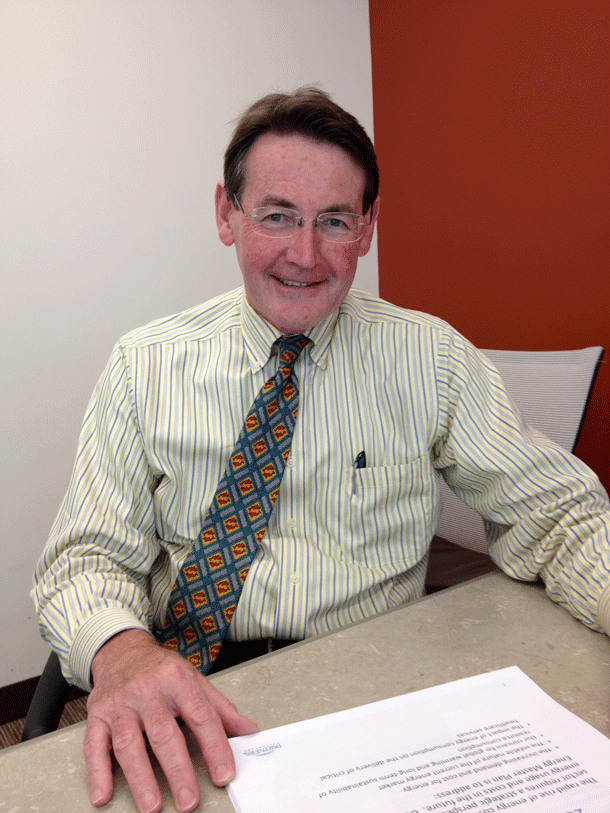
John Messervy (Photo: Steve Curwood)
MESSERVY: The sea level change is a concern and we responded in a couple of different ways. The ground floor of the building is set approximately 30 inches above the 500 year storm level and that may seem like a low probability of encountering a 500 year storm. In fact we’ve had three 100-year storms in the past couple of decades. So, they are coming.
[WALKING SOUNDS]
CURWOOD: As we walk through the construction site up to the nearly completed 8-story building, a massive cluster of generators and other heavy electrical gear on top in a penthouse is visible all the way from the ground.
MESSERVY: We’ve raised most of our sensitive electrical equipment and phone system and generating equipment up to the penthouse. In the name of providing a resilient environment for the continuance of health care services in the middle of a storm that’s what we ended up doing and I think you’ll see more and more hospitals and other buildings following suit. If you’re on the water front you need to protect electronic equipment and otherwise you’re going to be out of business.
[BACKGROUND CONSTRUCTION SOUNDS CONTINUE]
CURWOOD: Led by Brigham and Women’s and Massachusetts General Hospital, Partners Healthcare is the largest network of clinicians and hospitals in Eastern Massachusetts. Back in 2008 when energy price hikes blew a 40 million dollar hole in their budget, Partners set a goal of reducing its energy use by 25 percent. They also set about incorporating the latest green building concepts throughout their network and plan to build remote solar farms to help power their system.
[JACK HAMMER]
CURWOOD: The new Spaulding is being built in Charlestown on land reclaimed from an abandoned boat yard not far from Old Ironsides, the USS Constitution, the world’s oldest commissioned warship.
MESSERVY: We’re using a lot of the found materials on site. Granite and old ships’ timbers because this after all was a ship building community here in Charlestown so we found a lot of live-oak timbers that are being used both for site furniture and also refinished and being used inside the building.
[WALKING SOUNDS INTO TRAILER]
MESSERVY: Let’s go into the construction trailer, get hard hats then we can go inside the building.
MESSERVY: (Converses with hard hat distributors)… hello… how are you? Fine. Came to get a couple of hard hats. Is that tight enough for you? Let's see here - screw the knob on back and you're all set.
CURWOOD: We step inside the ground floor where workers are putting the finishing touches on a huge atrium that looks out onto a large plaza at the water’s edge.
[HAMMER SOUNDS]
MESSERVY: The design of the new Spalding took into account a lot of opportunities that we were presented with by the site. It’s essentially out at the end of a peninsula in the Charlestown navy yard. It gets a lot of sun. So we’ve designed the building to be quite thin and long so the sun can penetrate deeply into the space and reduce the amount of artificial light that we need.
CURWOOD: Patients can spend a lot of time in a rehabilitation hospital, and natural light with views of nature have been shown to improve the quality of recovery. We take an elevator see some of the almost finished patient rooms.
[ELEVATOR BEEPS, WALKING SOUNDS]
CURWOOD: We’re on the 8th floor of this new hospital you’re building, Spalding. And we’re looking out at Boston Harbor, this is an amazing view. I mean this is prime real estate. Hospital, here?
MESSERVY: Well, you know, it’s an interesting story. We wanted to stay in the city of Boston and there are very few sites available in the city these days. This site was available that the city owned and unfortunately it was contaminated. And once we started digging and testing we found a lot of chemicals that we had to remove so let’s say it was a discounted site and we paid for the cleanup. But it was worth it because it is a spectacular view and the patients and staff are going to find this to be a wonderful location for their work and recuperation.
CURWOOD: So, what are the things you do to cut energy in a hospital system?
MESSERVY: Well, some of them are really pretty dumb. You know, it’s turning off heat and air in rooms that are not occupied at different times of the day. And that is producing a significant savings. I’d say 40% of the savings that we’re realizing are coming from reducing temperature and air changes in unoccupied spaces such as operating rooms in particular.
CURWOOD: So, you’re on your way to a 25% reduction in the carbon footprint in the Partner’s Health Care system. What’s that worth in terms of dollars each year?
MESSERVY: For us it’s worth about 16 million dollars to reduce our energy consumption by 25% and we hope to go further than that as we get more involved in renewables and we hope to continue to drive those costs down at the same time as we implement more cogeneration facilities, combined heat and power facilities across the hospitals that will also realize another 25% or so savings over the power that we’re buying now.
Our return is about 3.7 years on the investments we’re making in conservation so they’re very rapid. As our CFO likes to say where else can I invest my money and realize a 27% return?
CURWOOD: So, you’re saving energy. You’re a health care company. How does this help save lives?
MESSERVY: Well, it saves lives by reducing our carbon emissions. In terms of our energy use and our carbon footprint, because we are such a large energy user we are emitting large amounts of particulates. The impact on the population is through conditions such as asthma, emphysema and other conditions. We are indirectly contributing to 10 million dollars worth of health care costs through our carbon emissions.
CURWOOD: And lost lives.
MESSERVY: And lost lives, that’s right.
[CONSTRUCTION SOUNDS]
CURWOOD: John Messervy of Partners Healthcare says construction will continue until the new Spaulding is ready for patients in April of 2013.
[CONSTRUCTION SOUNDS FADE OUT]
CURWOOD: Gary Cohen of Health Care without Harm says sustainable hospitals are a national trend.
COHEN: Hospitals all round the country and around the world are moving towards sustainability as a core business strategy and energy efficiency is one of those core planks. Health Care Without Harm and our membership organization, Practice Green Health, and 12 other hospital systems around the country, have launched a sector-wide initiative called the Healthier Hospital Initiative.
At the moment there are 500 hospitals that are sponsors of this initiative. We’ve been able to recruit another 200 hospitals and our goal is to reach 2,000 hospitals to enroll in the Healthier Hospitals initiative, which would represent one third of all the hospitals in the country. And so we are working with many, many hospitals around the country to have health care lead the movement for a sustainable development within the frame work of their mission to do no harm.
CURWOOD: Gary Cohen of Health Care Without Harm. He says that if you don’t have a clean and green health care facility near you like the new Spaulding, you likely soon will.
Related links:
- Health Care Without Harm
- Partners Healthcare Sustainability Plans
[MUSIC: Donald Fagan “Planet D’Rhonda” from Sunken Condos (Reprise Records 2012).]
The Long Rise: Mark Seth Lender
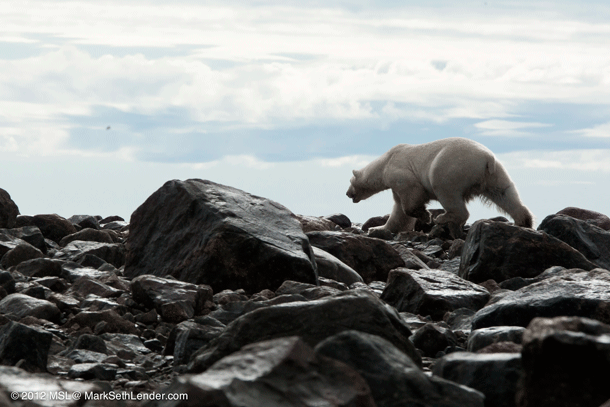
A polar bear running. (Photo: Mark Seth Lender)
CURWOOD: Scientists say ice in the Arctic melted more this year than ever before.
But even as the ice diminishes, the land and landscape in the far north remain stark, strange, and perhaps threatening. At least, that's what writer Mark Seth Lender experienced on a visit to Churchill Wild on Hudson Bay as summer came to a close.
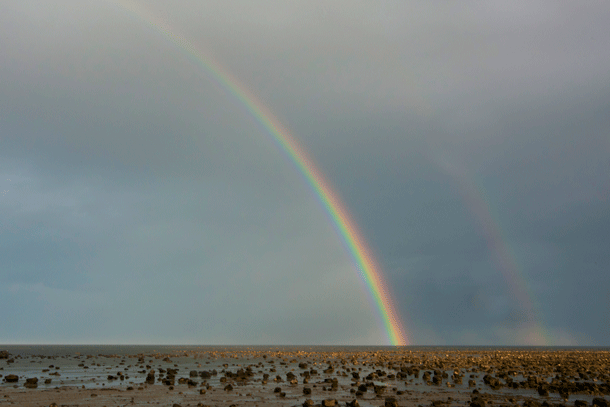
Rainbow over Hudson Bay (Photo: Mark Seth Lender)
LENDER: The storm passed in the night. There was a rainbow late in the afternoon, huge even in the vast expanse of Hudson Bay and the rocky flats that stretch for miles and miles. It lasted for a long time, almost till the sun went down. The intervening night is short though the Solstice is more than a month behind us.
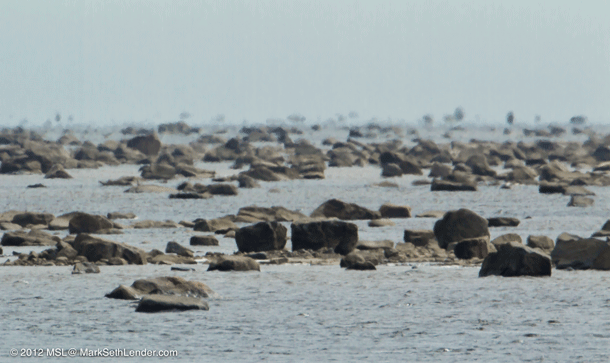
Hudson Bay (Photo: Mark Seth Lender)
The glows that begins at half-past three continues two hours more before the arctic sun (orange, harsh, stripped-down) rises unceremoniously. Unceremonious, because despite the tedium of the waiting when it happens it happens all-at-once. Stripped-down, without a touch of moisture in the air to clothe the nakedness.
Soon, very soon, the sun will not rise at all, and there will be at this latitude only the pale, perpetual dawn of arctic winter night. And this last hour before day is a foreshadowing, the world ruled by the dark of the shoreline, and the sea strangely brighter than the face of the sky, ragged and white-capped, like an old mirror backed in mercury, the polish here and there worn through.
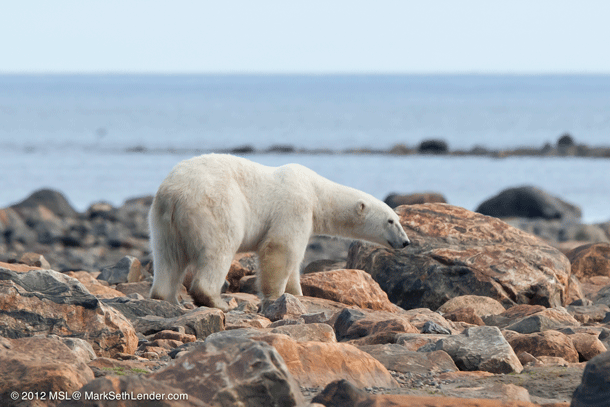
A polar bear comes up on the point. (Photo: Mark Seth Lender)
In the shadow-lit landscape three polar bears come out of nowhere. They climb up and onto the point. Two together move further out. One stays, a cutout of bear just above the distant crease of horizon. He is a mountain, of darkness, the hump of shoulders and the bump of hips two worn peaks. And suddenly I am seen. And suddenly, he runs. This startles the other two and they run. And though it does not look fast because their improbable size destroys all scale, it is fast enough, and a good thing they’ve chosen to run the other way. Only memory reveals their whiteness.

Polar Bear tracks. (Photo: Mark Seth Lender)
CURWOOD: Mark Seth Lender is the author of Salt Marsh Dairy, A Year on the Connecticut coast. For the photos he took -- head on over to our website, loe dot org.
Related link:
More about Mark Seth Lender
[MUSIC: Marc Johnson/Eliane Elias “Foujita” from Swept Away (ECM Records 2012).]
CURWOOD: Coming up – the strange tale of the talking whale. Keep listening to Living on Earth!
[CUTAWAY MUSIC: Marc Johnson/Eliane Elias “Foujita” from Swept Away (ECM Records 2012).]
ANNOUNCER: Funding for Living on Earth comes from the Grantham Foundation for the Protection of the Environment, supporting strategic communications and collaboration in solving the world’s most pressing environmental problems. The Gordon and Bette Moore Foundation. The Kandeda Found, furthering the values that contribute to a healthy planet. And Gilman Ordway for coverage of conservation and environmental change. This is PRI. Public Radio International.
The Whale that Spoke Human
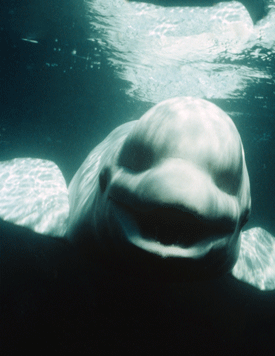
Noc the talking whale. (Photo: Sam Ridgway)
CURWOOD: It's Living on Earth - I'm Steve Curwood. Beluga whales are known as "canaries of the sea" because of their musical voices and talkative nature. Legend has it that sailors believed the songs of belugas were the voices of drowned men speaking from beneath the waves.
Well, new research suggests that belugas may be able to sound human, giving some basis to these old maritime myths. Living on Earth’s Emmett FitzGerald updates the yarn.
FITZGERALD: If there's anybody out there who speaks whale - it's Dr. Sam Ridgway. He’s been studying the behavior of marine mammals for a very long time.
RIDGWAY: I recently figured it out… it’s been 52 years and 8 months. I worked with mainly bottlenose dolphins, California sea lions, and white whales. I call them white whales, I like the name better than beluga whales.
FITZGERALD: Dr. Ridgway is a neurobiologist and the President of the national Marine Mammal Foundation, and he’s just published a paper in the journal Current Biology. The paper argues that belugas are capable of imitating the speech patterns of humans. This research began way back in 1984. Dr. Ridgway was working with a group of three belugas from the Arctic when something very strange occurred.
RIDGWAY: One day, we started hearing noises, like a distant conversation on another pier here in San Diego Bay. We didn’t think much of it because we thought it was a human conversation. But then, a diver who was using underwater communications equipment, got out of the water and said, ‘who told me to get out?’ and he was next to this whale’s pen and the dive supervisor had not said anything or told him to get out and now the only alternative was the whale.
FITZGERALD: The researchers determined that the human-like noises were coming from a whale they called No-see-um. Noc for short, after the swarms of maddening insects that thrive in the Arctic. Once he was moved to San Diego, Noc spent a lot of time with divers, trainers, and veterinarians. At some point, it seems, the white whale began to mimic the sounds he heard coming from his human caretakers. These new noises were several octaves lower than his normal register.
So, Noc needed to develop a special method to create them. He learned how to over-inflate two air sacs above his nasal cavity – a behavior never before seen in beluga whales. Dr. Ridgway compares Noc’s new voice to another famous musician.
RIDGWAY: One example I’d give is a human trumpeter - normal trumpeters play music and they do it very well, but Louis Armstrong could make the trumpet talk and make pops and do all sorts of unique things, so this is a whale that taught his vocal system to do something a bit different.
FITZGERALD: We’ve got a recording of Noc speaking human. Here it is:
[SOUNDS OF WHALE]
FITZGERALD: Dr. Ridgway doesn’t argue that Noc is saying real words, but these noises are very different from normal beluga songs:
[SOUND OF BELUGAS, HIGH SQUEaKS]
FITZGERALD: It wasn’t only the unusual sounds that Noc made. Dr. Ridgway did a visual analysis of patterns in the whale’s speech. When viewed through a device called a spectrogram, Noc’s voice patterns looked remarkably human. Though we may never have a conversation with a whale, Dr. Ridgway believes we can already communicate with whales in basic ways.
RIDGWAY: We train them to make a certain sound and they tell us when they hear another sound. So, we can communicate on that level. Who knows to what extent we can learn to communicate with these animals. We hope that others will take this up and do more rigorous work.
FITZGERALD: Scientists still have a lot to learn about whale communication. Although Noc died five years ago, Dr. Ridgway hopes that the strange noises he created will inspire further research into these curious ocean creatures. For Living on Earth, this is Emmett Fitzgerald.
Related link:
More about Dr. Sam Ridgway and the National Marine Mammal Foundation
[MUSIC: Louis Armstrong “All That Meat And No Potatoes” from Satch Plays Fats (Columbia Records 1956).]
Eternity of Eagles
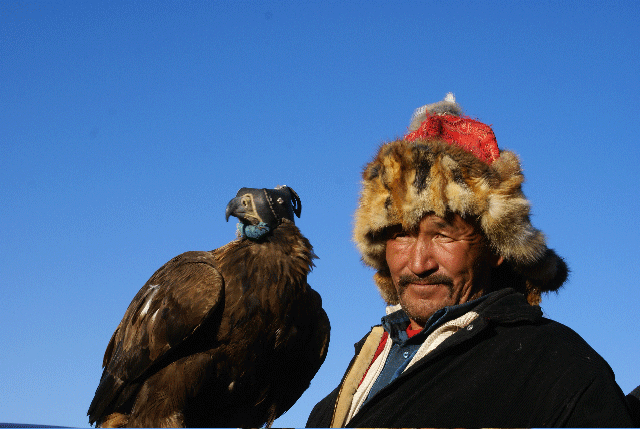
(Photo: Cat Urbigkit)
CURWOOD: Although Benjamin Franklin thought the turkey would make a better national emblem for the United States, we wound up with the Bald eagle - hardly a surprise, as eagles have fascinated and inspired humans throughout history.
Nature writer Stephen Bodio fell under their spell - his new book details the complicated place of eagles in a variety of human cultures. The richly illustrated work called "The Eternity of Eagles" takes us from central Asia where the Kazakh tribes use eagles to hunt wolves, to the American West where herders once shot them from aircraft to protect their flocks. Steve Bodio joins us from Albuquerque, New Mexico. Welcome to Living on Earth, Steve.
BODIO: Glad to be here!
CURWOOD: So, tell me, what makes an eagle, an eagle? I mean, is this just a name or is there some real biological distinction between eagles and the other birds of prey… I’m thinking of goshawks, and harriers, all kinds of birds of prey.
BODIO: The word eagle covers 80-odd species, depending on your taxonomy. We use it in English to mean a number of things – almost more cultural than biological – large bird of prey. We also call various things eagles that might be better called harriers or hawks or giant kites or something completely unique.
On the other hand the truest eagles, the Aquila eagles, the animals we first called eagles, and their relatives, are a very distinct bunch of large, intelligent, active predators, usually with feathered legs. They’re biologically related birds, you know, a natural evolutionary group. So, there’s the essential eagle and there’s the broad constructed concept eagle.
CURWOOD: So, what’s your favorite eagle?
BOLIO: My favorite eagle is the Golden Eagle. That’s the eagle that really is eternally, metaphorically with our culture. It is a hunter, an intelligent bird, a bird that has been trained very early by human cultures as a useful and interesting companion. It can live on young herons in the Maritimes or on turtles in Greek islands. It was the Roman war eagle, it was the symbol for that. An enemy to some cultures and a friend to others. It is a universal eagle, I think.
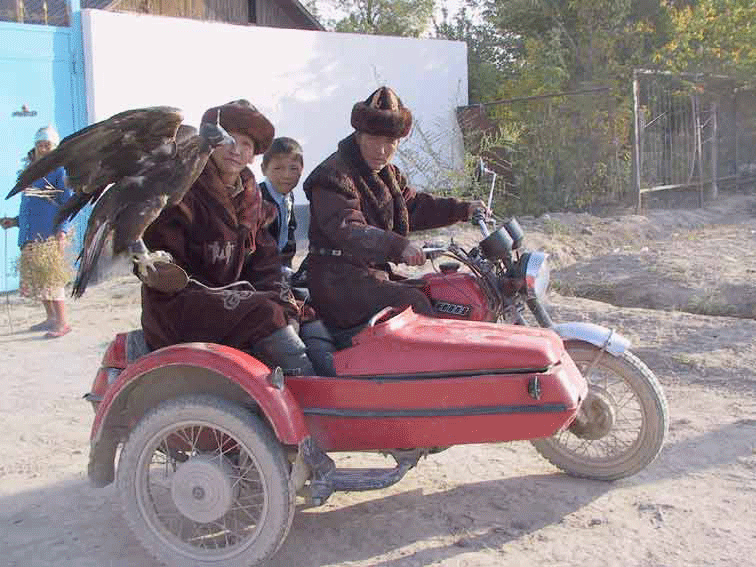
Going hunting outside Nura Village, near Charyn Gorge, Kazakhstan, on Russian motorcycle. (Photo: Wolfgang Regar)
CURWOOD: What is one of your favorite eagles that we may not have heard of?
BOLIO: Favorite eagle you may not have heard of, which is barely an eagle but has the name, is the Bateleur of Africa, which is related to the group called snake eagles, but resembles a flying wing. It has almost no tail, huge wings.
In the skies of southern and eastern Africa, there’s always one up, almost like the redtails soaring in the east or turkey vultures in the west, except it’s moving like some sort of science fictional airplane, barely beating its wings but it’s going by at about 60 miles per hour. Rocking slightly on the wind. They cover hundreds of miles per day with barely a flap and they’re very pretty in an exotic way.
CURWOOD: Steve, now, you’ve spent a great deal of time in central Asia, please describe for us how people use eagles to hunt there… and I understand they hunt for wolves?
BOLIO: They hunt for wolves. Their day-to-day hunting is probably more for fur animals and for some food animals. Fox is probably the most popular quarry, and that’s very easy, that’s just like a hawk catching a rabbit once they learn how to do it. But wolves are an important stock predator in central Asia and most people don’t have firearms, certainly didn’t have them until the fall of the Soviet Union and an eagle is capable of killing a wolf.
The eagle flies in, quickly grabs the wolf by the muzzle to immobilize its teeth, which are its only weapon, really unlike a cat, and grabs it by the neck or breaks into the chest with its incredibly powerful foot, and basically has it opened in a minute or two – its large blood vessels opened – and kills it very efficiently.
CURWOOD: What brought you to central Asia?
BOLIO: A lot of romantic travel people fixated on Africa or on South America, and for some reason I was fascinated with Central Asia from the get-go. I saw a picture of what I now know was a Kazakh herdsman in some magazine when I was about five in Boston.
And the guy was wearing the clothes of a snow leopard and had an eagle on his fist and I just fixated on this and said to myself, not even consciously… I need to see that, I need to go there. And after the Soviet Union fell, I immediately started making queries of friends I knew that traveled… have you seen eagles, have you seen Kazakhs, have you met Kazakhs?
I met a really interesting couple in Brooklyn in Brighton Beach who showed me films of eagles and wolves and got contacts and eventually flew out in February… mid-winter, I wanted to be able to see some hunting, it turned out to be a little late in the season, but better than too early, into Ulaanbaatar, into a night of 40 below zero and then 600 more miles without pavement to Bayan Olgii, the Kazakh state of Mongolia, and a day later I was looking at a hunting eagle perched on a truck tire and knew I had arrived.
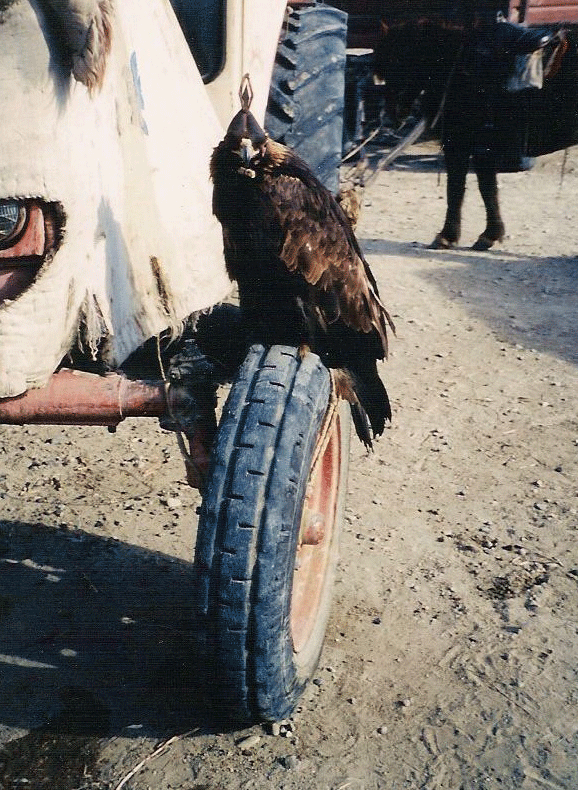
A Kazakh eagle, perched on a tire of a truck in Bayan Nuur outside of Olgii city. Photo: Steve Bodio)
CURWOOD: (Laughs.) On a truck tire, huh?
BOLIO: On a truck tire. One of the amusing things, wonderful things of central Asian eagle culture, it’s incredibly pragmatic. Tire makes a great perch, certain synthetics make interesting jesses’ materials, modern sort of high tech outdoor clothing is warm and can be worn underneath your traditional fur robes, and why not? And they’re still doing something they’ve been doing for thousands of years and are happily making use of modern technology. One of the fun photographs in there is a bird riding in a side car of a Russian motorcycle going up and down the streets!
CURWOOD: Now, tell me, how do the Kazakhs train these eagles that they use to hunt?
BOLIO: The taming is merely familiarizing. The Kazakhs do one particularly odd thing, they put the bird on what looks like a hammock rolled up - tethered at both ends, and it’s sort of a swinging perch, hooded, to make it have to constantly be changing its grip and a little off-base while they gradually expose it to humans, to children, to dogs, to horses, and to food.
And they feed the bird, which I find interesting, off the point of a knife or out of a bowl rather than their fingers so it’s obviating being bitten or snatched easily. The taming goes like that. And eagles are very intelligent, like most birds of prey, and even as adults tame down really fast.
After each of those training processes, you simply teach, think of teaching a dog… you teach the bird to come when it’s called… here’s the food, whistle, whistle, here’s the food, come on…come on, boy. Or, actually, mostly girl, because, one thing that we haven’t touched on but is commonplace in the bird of prey people - female birds of prey are larger and stronger than the males, almost inevitably.
The more predatory the species, the more likely this dichotomy. Very few males are trained by the Kazakhs, and when I once asked an older Kazakh, perhaps blunter than my friends of my own age, if he ever trained a male and he said ‘do I look like I hunt mice?’
CURWOOD: (Laughs.) So, what was it like to ride with the Kazakh eagle tribes?
BOLIO: Completely delightful, they’re the most hospitable people in the world. I could not ride all day, and all day and as fast as these people could. I mean, I didn’t grow up on horseback. But you’d go out in this freezing weather and go out over hill and rock and ice and very little vegetation, just looking for the flight of the fox and you learned to really appreciated boiled mutton and hot tea with butter in it and shots of vodka by the time you came back to the house – as they called their winter-spending place, their adobe houses. I’ll do it as long as I can afford and walk.
CURWOOD: Now, currently, what are the major threats to the world’s eagles?
BOLIO: Habitat destruction. And of course the unknown consequences of climactic change. If an eagle has a very small habitat, an island habitat or a marginal habitat, a change could make it very difficult. And I think our classical eagle, our Golden, is not under danger to thrive, it’s likely to outsee our species if we don’t wise up.
But some other eagles with small ranges or threatened habitats – those are the ones that I really worry about. Also, a peculiar, very ambivalent threat, ambivalent in the sense that we are trying to do it for good reasons – wind farms are a real problem for eagles. They’re supposed to be clean energy, but I wonder if the ecological costs of such things on bird populations might be more than we would be willing to pay if we understood them.
CURWOOD: Let’s talk about the future of the eagle. No, better yet, let’s have you read from the very end of your book, the last paragraph that you have.
BOLIO: Sure. ‘Eagles will continue to be eagles, splendid, and for the most part, indifferent to our ways. Some of us will always be obsessed with them: love them, hate them, make art or friends of them. They don’t care. They ask nothing but to go on their splendid old dinosaurian way, over our heads, in or out of our minds. They need us less than we need them.
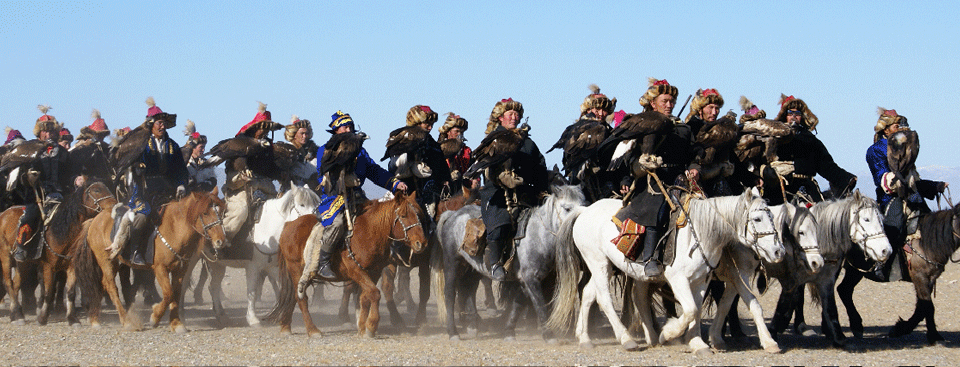
The parade at the annual (September) eagle festival in Olgii. (Photo: Cat Urbigkit)
If we leave them a space, they cannot live in cities (though balds may yet); they may outlive our restless species, as they pre-date us. If they don’t, we may find that many eagles may vanish, leaving only the eagles of the mind that we’ve created in their image. We will be the poorer for it, but I confess, I doubt it will ever happen.
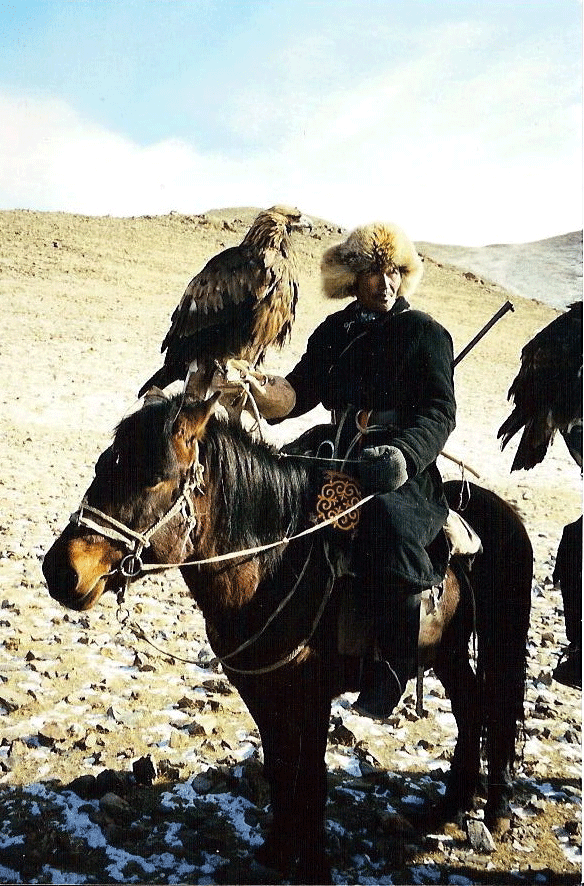
I suspect it’s more likely that Aquila will pass like a shadow over the last human ruins, casting a benign predator’s glance at them as she hunts on down the wind.
CURWOOD: Stephen Bodio is a writer, naturalist and falconer from New Mexico. His latest book is called: An Eternity of Eagles: The Human History of the Most Fascinating Bird in the World. Thanks so much, Steve!
BODIO: Thank you - this was fun!
Related links:
- Stephen Bodio’s Blog
- An Eternity of Eagles
[BirdNote® THEME]
BirdNote®: Screech-Owl
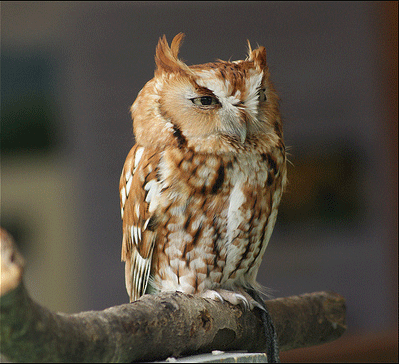
Eastern Screech-Owl red morph (Photo: © Diane E. Newbery.jpg)
CURWOOD: From the noble eagle, to birds of a very different feather. At this time of year thoughts turn to things ghostly and strange. And as BirdNote®'s Mary McCann points out - the avian kingdom has its own scary actors.
[EERIE TRILL OF AN EASTERN SCREECH-OWL]
MCCANN: Sometimes, owls strike us as downright spooky. The spine-tingling call of an Eastern Screech-Owl is a case-in-point.
[EERIE TRILL OF AN EASTERN SCREECH-OWL]
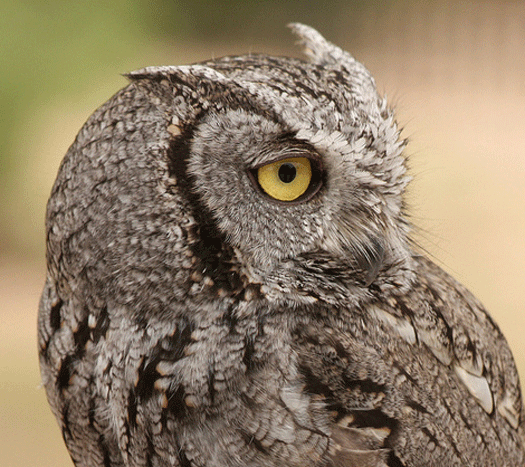
Western Screech-Owl (Photo: © James N. Stuart)
MCCANN: Equally eerie is an owl’s seeming ability to rotate its head in a complete circle.
[THERAMIN MUSIC THAT SOUNDS LIKE OWL CALL]
MCCANN: Are spectral forces at work here, enabling an owl to spin its head 360 degrees? Or do its neck feathers hide some anatomical secret?
Well, an owl’s apparent head rotation is part illusion, part structural design. To begin with, because an owl’s large eyes are fixed in their sockets, it must rotate its neck to look around.
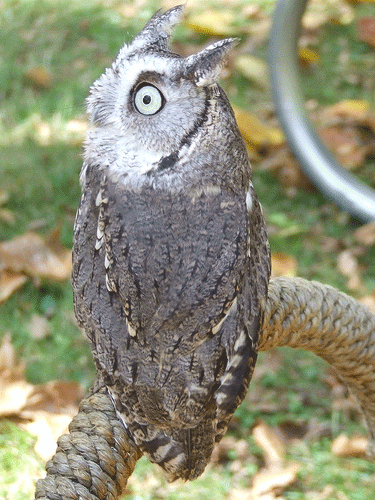
Eastern Screech-Owl (Photo: © Anne Bennett)
And an owl will frequently perch with its head turned, looking over its shoulder to prevent predators from sneaking up behind. Hearing a noise from an unseen source, the owl rotates its head to the front and then around to the opposite shoulder in one quick, smooth movement, in what appears to be a full circle. Uncanny.
The actual rotation is about 270 degrees. With 14 neck vertebrae – that’s twice as many as you have – an owl can turn its head 90 degrees further than you can. Even without any occult forces at work, this is a marvelous anatomical feat.
I’m Mary McCann.
CURWOOD: For pictures and more - glide on over to our web-site, loe dot org.
[Eastern Screech-Owl audio provided by The Macaulay Library of Natural Sounds at the Cornell Lab of Ornithology, Ithaca, New York.
Recorded by W.L. Hershberger.
Producer: John Kessler
Executive Producer: Chris Peterson
© 2012 Tune In to Nature.org October 2012 Narrator: Mary McCann]
Related link:
BirdNote®
[SOUNDS: “Humpback Whale” from Sounds Of The Deep (British Sound Library Archive 2007).]
CURWOOD: We leave you this week under the sea - with another singing whale…
[HUMPBACK WHALE SOUNDS]
CURWOOD: This is a Humpback, a lone male recorded in the Caribbean. These complex melodic calls are used to attract potential mates,
[WHALE CALLS]
CURWOOD: The Humpback's scientific name, Megaptera Novoangliae means Big Wings from New England - one of its most distinctive features is the long barnacle encrusted flippers. This whale was recorded by the International Fund for Animal Welfare for the British Library CD Sounds of the Deep.
[SOUNDS: “Humpback Whale” from Sounds Of The Deep (British Sound Library Archive 2007).]
CURWOOD: Living on Earth is produced by the World Media Foundation. Bobby Bascomb, Emmett Fitzgerald, Helen Palmer, Annie Sneed, James Curwood, Meghan Miner, Gabriela Romanow and Sammy Sousa all help to make our show. Jeff Turton is our technical director. Alison Lirish Dean composed our themes. You can find us anytime at L-O-E dot org - and check out our facebook page - it’s PRI’s Living on Earth. I'm Steve Curwood. Thanks for listening!
ANNOUNCER: Funding for Living on Earth comes from Stonyfield Farm, makers of organic yogurt, smoothies, and more. Stonyfield invites you to just eat organic for a day. Details at just eat organic dot com. Support also comes from you our listeners. The Go Forward Fund and Pax World Mutual and Exchange Traded Funds. Integrating environmental, social, and governance factors into investment analysis and decision making. On the web at Pax World dot com. Pax World, for tomorrow.
ANNOUNCER 2: PRI Public Radio International.
Living on Earth wants to hear from you!
Living on Earth
62 Calef Highway, Suite 212
Lee, NH 03861
Telephone: 617-287-4121
E-mail: comments@loe.org
Newsletter [Click here]
Donate to Living on Earth!
Living on Earth is an independent media program and relies entirely on contributions from listeners and institutions supporting public service. Please donate now to preserve an independent environmental voice.
NewsletterLiving on Earth offers a weekly delivery of the show's rundown to your mailbox. Sign up for our newsletter today!
 Sailors For The Sea: Be the change you want to sea.
Sailors For The Sea: Be the change you want to sea.
 The Grantham Foundation for the Protection of the Environment: Committed to protecting and improving the health of the global environment.
The Grantham Foundation for the Protection of the Environment: Committed to protecting and improving the health of the global environment.
 Contribute to Living on Earth and receive, as our gift to you, an archival print of one of Mark Seth Lender's extraordinary wildlife photographs. Follow the link to see Mark's current collection of photographs.
Contribute to Living on Earth and receive, as our gift to you, an archival print of one of Mark Seth Lender's extraordinary wildlife photographs. Follow the link to see Mark's current collection of photographs.
 Buy a signed copy of Mark Seth Lender's book Smeagull the Seagull & support Living on Earth
Buy a signed copy of Mark Seth Lender's book Smeagull the Seagull & support Living on Earth

